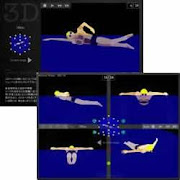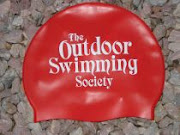 Open water swimmers are always outdoors, often in the bright sun. We use lanolin (see below), Vaseline®, BodyGlide, Adeps Lanae, wool wax, anhydrous wool fat, wool grease, and SkinLube® and various kinds of sunscreen, ranging from Bull Frog Sun Block to Watermans Applied Science.
Open water swimmers are always outdoors, often in the bright sun. We use lanolin (see below), Vaseline®, BodyGlide, Adeps Lanae, wool wax, anhydrous wool fat, wool grease, and SkinLube® and various kinds of sunscreen, ranging from Bull Frog Sun Block to Watermans Applied Science.While we prepare ourselves physiologically and psychologically for major swims, often times protecting our skin is an afterthought. Here's a brief primer on sunscreens:
+Britta+pre-race.jpg) Skin cancer is one of the most common form of cancers. More than 1 million skin cancers are diagnosed annually in the U.S. alone. More than 90% of all skin cancers are caused by sun exposure.
Skin cancer is one of the most common form of cancers. More than 1 million skin cancers are diagnosed annually in the U.S. alone. More than 90% of all skin cancers are caused by sun exposure. The sun gives off ultraviolet radiation that is divided into categories based on the wavelength.
UVC - 100 to 290 nm
UVB - 290 to 320 nm
UVA - 320 to 400 nm
UVA was once thought to have a minor effect on skin damage, but studies show UVA is a major contributor to skin damage. UVA is a high-energy wave that penetrates deeper into the skin to do its damage. The intensity of UVA radiation is more constant than UVB without the variations during the day and throughout the year. UVA is not filtered by glass. UV-A can be further subdivided into UV-A I, or far UV-A (340-400 nm), and UV-A II, or near UV-A (320-340 nm).
UVB affects the outer layer of skin and is the primary agent responsible for sunburns. It is more intense in the summer months accounting for 70% of a person's yearly UVB dose. UVB does not penetrate glass.
The Breakdown: The damage done to the skin is cumulative and is never completely repaired. Rain or shine, the damage is being done. UVA radiation is constant and does not vary by season or time of day. UVA does not cause burns, but it does cause advanced aging and cancer. UVB causes burns, but it varies in intensity by season and time of day. Both UVA and UVB can cause cancer.
Skin Types: Everyone has a different skin complexion genetically determined largely by melanin content. To simplify the huge variation in the different types of skin, all people are categorized into one of six skin types (based on the Fitzpatrick Phototype Scale).
Knowledge of skin type is vital in determining the safe period of sun exposure calculated with the UV Index for that day. It is also required to calculate how your safe period of sun exposure is extended with the applicable SPF (Sun Protection Factor) of the sunscreen that is being used. Below is a list to help identify the skin type and aid in determining sunscreen needs.
Type # 1 – Ivory white, no tanning ability, always burns easily.
Type # 2 – White, minimal to weak tanning ability, high inclination to sunburn.
Type # 3 – White, low tanning ability, moderate inclination to sunburn.
Type # 4 – Beige-Olive, lightly tanned, moderate tanning ability, very low inclination to sunburn.
Type # 5 – Moderate brown or tanned, sun insensitive skin, very low inclination to sunburn.
Type # 6 – Dark brown or black, sun insensitive skin, never burns.
Finding the proper dosage is important; the U.S. Food and Drug Administration and the Skin Cancer Foundation recommend choosing a sunscreen based on specific needs. Choosing the right SPF product is relatively simple. The SPF rating is basically a multiplication table. If you regularly burn in ten minutes and you are wearing an SPF 33 then you will burn in 333 minutes (burn time without sunscreen x SPF factor of sunscreen = burn time with sunscreen).
Inorganic vs. Organic Sunscreens: Organic sunscreens are commonly known as 'chemical.' These agents protect against UV by absorbing the energy from UV rays. Inorganic sunscreens, such as metal oxides or particulate UV filters, are often termed 'physical' or 'mineral.' The metal oxides, namely titanium dioxide and zinc oxide, are insoluble particles, which absorb and reflect UV. The differences between these active ingredients are primarily based on their solubility, with organic UV filters existing in solution and physical ones being suspended or insoluble. The effectiveness of physical/mineral sunscreen agents depends on their presence on the outer layer of the skin and the effectiveness of the organic sunscreens is dependent on the skins ability to absorb the sunscreen agent. For this reason it is important to find a good mix of both physical and organic sunscreen agents in order to ensure consistent broad-spectrum protection.
The Skin Cancer Foundation recommends, "a broad-spectrum sunscreen offering protection against both UVA and UVB rays. These sunscreens combine several different active chemical sunscreen ingredients in order to provide broad-spectrum protection. Usually, at least three active ingredients are called for. These generally include PABA derivatives, salicylates, and/or cinnamates (octylmethoxycinnamate and cinoxate) for UVB absorption; benzophenones (such as oxybenzone and sulisobenzone) for shorter-wavelength UVA protection; and avobenzone (Parsol 1789), ecamsule (Mexoryl), titanium dioxide, or zinc oxide for the remaining UVA spectrum."
A combination of zinc or titanium and at least two chemical sunscreens is recommended by the U.S. Food and Drug Administration, the Skin Cancer Foundation and the American Academy of Dermatology as a must when picking a sunscreen. However, even when looking at Zinc and Titanium there is a difference. Zinc is by far superior, however, it does not lend itself well to sticks and is found primarily in lotions.
Note: there is no such thing as sun block. Even a SPF 50 product only blocks 97% of the suns rays. Because 3% still get through, it is considered a filter rather then a block.
Glossary
Very Water-Resistant: Product has been tested to remain effective for at least 80 minutes in the water.
Water-Resistant: Product has been tested to remain effective for at least 40 minutes in the water.
Sun Block: a term used to describe higher SPF products (>SPF15). Technically there are no real sunblocks, only sunscreens or sun filters.
Non-Comedogenic: A term applied to oils, lotions, and skin creams that do not block poors.
Non-Migratory: Does not migrate or change location.
Broad-Spectrum: A term used to describe products that contain both UVA and UVB sunscreens.




















No comments:
Post a Comment